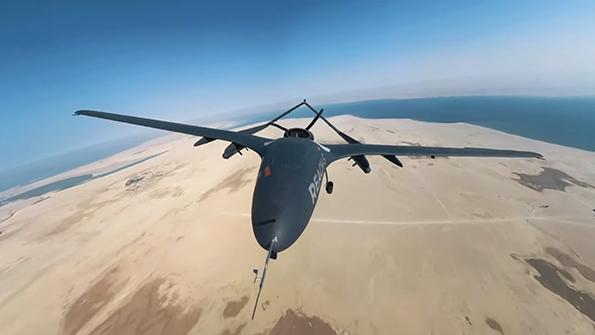
The Edge Group is flying the Reach-S at a newly established test range on Abu Al Abyad Island near Abu Dhabi.
The United Arab Emirates has joined a growing number of countries capable of developing an armed uncrewed aircraft system.
The indigenous twin-boom Reach-S, developed by the Emirati defense firm Edge Group, has gone from concept sketch to dropping munitions in just 36 months, the company’s chairman, Faisal al-Bannai, told Aviation Week at the Dubai Airshow in mid-November.
- Production of the indigenous Reach-S is due to begin in 2024
- UAE has ordered 120 Baykar TB2 and Akinci UAS
- Locally developed munitions could arm the MQ-9B
Development of the aircraft is at an early stage. Edge officials say the system has completed a handful of flight tests and begun a weapon-release campaign using its Desert Sting munition. Next steps include long-endurance flights. Perhaps more crucial, however, production of the system—which is due to start next year—has been bolstered by a 100-aircraft order by the United Arab Emirates (UAE) Armed Forces. The order signals not only confidence in the platform by the domestic customer, but also the enormous scale of uncrewed aircraft system (UAS) operations envisaged by the UAE and its neighbors, such as Saudi Arabia.
In Europe, by comparison, air forces are conservative about the size of their UAS operations. Their inventories may feature one or two squadrons flying medium-altitude, long-endurance platforms, often for intelligence, surveillance and reconnaissance duties, as nations determine strategies to move toward more capable systems that could complement their front-line combat aircraft.
In the UAE, those 100 Reach-S will join an already sizable fleet of platforms acquired from China, Turkey and the U.S. A deal with Turkey’s Baykar indicates the UAE’s voracious appetite for UAS capability. Abu Dhabi is purchasing 60 examples each of the Bayraktar TB2 platform and the twin turboprop Akinci, supplied through the UAE’s International Golden Group, industry officials said.
The Gulf state also continues to use exportable versions of the General Atomics-Aeronautical Systems (GA-ASI) RQ-1 Predator it received almost a decade ago, along with a large number of Chinese-built platforms. Some of the latter might have been phased out with the arrival of the Turkish platforms, as they have in other Middle Eastern countries.
Beyond these orders, Abu Dhabi still harbors ambitions to buy the 18 GA-ASI MQ-9B Sea/SkyGuardians the Trump administration approved it to purchase along with Lockheed Martin F-35 Joint Strike Fighters. During the Dubai Airshow, the Edge Group announced it had signed an agreement with GA-ASI to integrate several UAE-developed munitions onto the platform.
If the effort proceeds, the UAE-made weaponry would be the first non-NATO munitions to be integrated onto the platform. However, officials insist the integration work would only happen if the MQ-9 purchase proceeds. Similarly, there are efforts to integrate UAE weapons onto the Baykar-developed platforms, as those systems generally carry Roketsan-developed munitions.
“The UAE wants to have one of the largest fleets of armed drones,” al-Bannai said. “It is a strategy that the country is investing in very heavily.” The reasons are unclear—the UAE has put a veil of secrecy over its UAS operations, never displaying acquired systems at defense events in the country, in direct contrast to its willingness to show off its crewed platforms.
Such a vast number of relatively low-cost aircraft systems gives the country significant combat mass, however. And the ability to operate several platforms from one ground station reduces reliance on staffing, which has long challenged the smaller Gulf states. It is also likely a response to Iranian investments in UAS and one-way attack drones, such as those sold to Russia.
Neighboring Saudi Arabia is also building a sizable fleet of UAS, and is turning to its rapidly developing national industry to build Baykar Akinci systems in-country in numbers likely to significantly exceed those of the UAE.
There is more to follow from the UAE, al-Bannai noted. The OEM has outlined a road map for further development of its UAS capabilities. The Reach-S is already being scaled up into the larger Reach-M platform, which will have a 1,500-kg (3,300-lb.) maximum takeoff weight (MTOW) and a payload capacity of 350 kg compared with the 600-kg MTOW and 120-kg payload capacity of the Reach-S.
Edge also revealed at Dubai that its investments in Polish very-light-jet developer Flaris would lead to the development of a jet-powered UAS called Sinyar that would be able to carry a payload of 450 kg and operate at altitudes of up to 30,000 ft.





